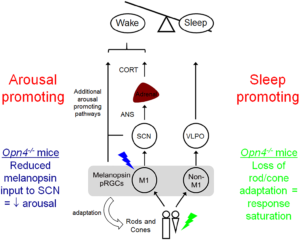Oxford scientists debunking the myths of blue light reduction

Research by the University of Oxford’s Sleep and Circadian Neuroscience Institute has shown that some of the most challenging diseases of our time, such as mental illness, neurological conditions, and developmental disorders, may be linked to sleep and circadian rhythm disruption.
This disruption has been linked to blue light since the discovery of a blue light sensitive light receptor in the retina of the eye, and there has been an increased focus on the biological effects of blue light, especially from mobile devices.The lighting and electronics industry have been keen to reduce blue light to decrease its effect on our circadian rhythms, as disrupting these rhythms (our “body clock”) may affect more than just our sleep patterns.
So, can we just reduce blue light and get our rhythm back? The short answer is no – simply reducing blue light may not be effective, especially if done in isolation. This is the focus of work being done by Prof Stuart Peirson within the Institute: his focus is on how light regulates physiology and behaviour, with a particular interest in how the modern artificial light environment disrupts these processes.
So, how can we ensure our work and home environments disrupt our body clock as little as possible? How can companies ensure that the claims they make for their lighting solutions are not just marketing and actually make a difference?
Those answers are complex and require that lighting engineers work with scientists to measure and manipulate light. Engineers need to understand biology, and scientists need to understand engineering limitations. Working together they can move towards human-centric lighting with proven claims. Oxford scientists such as Peirson can provide guidance to companies on what is most likely to make a difference based on the latest research, and can provide bespoke training to lighting engineers so they better understand the effects of biology.
Advice already provided includes a consultancy contract with a major multinational company who were interested in the plausibility of controlling alertness. The project entailed a state of the art literature review as well as an opinion on the effects of light on circadian rhythms and alertness.
If you or your company are interested in discussing a consultancy project with Peirson or the Institute, reach out to the team at Oxford University Consulting Services for more information.
(* image from Pilorz V, Tam SKE, Hughes S, Pothecary CA, Jagannath A, Hankins MW, et al. (2016) Melanopsin Regulates Both Sleep-Promoting and Arousal-Promoting Responses to Light. PLoS Biol 14(6): e1002482. https://doi.org/10.1371/journal.pbio.1002482)

